Just finished another semester of Visual Thinking at Loyola Marymount University. The individual expression of the students is what always keeps the course fresh and interesting. Here are some of their project images…
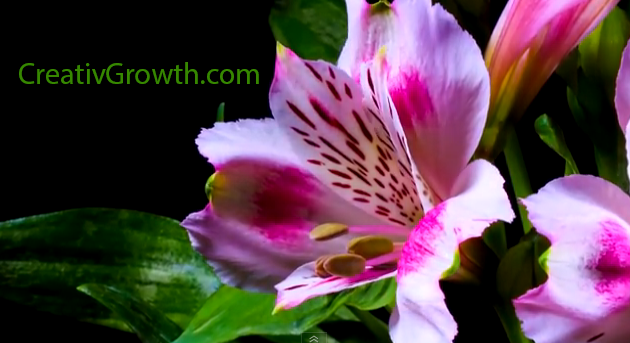
Just finished another semester of Visual Thinking at Loyola Marymount University. The individual expression of the students is what always keeps the course fresh and interesting. Here are some of their project images…
Comments of the Visual Thinking course by former students…
Camille:
It let me be creative in a way that wasn’t asking me to make perfect lines, but rather was asking me to create something relevant to how I was feeling. That was a new way of making art for me.
Cody:
I really loved this experiential approach to art. I connected it to way in which strong visual communication could make a positive impact, helping to solve some of most significant global problems.
Ever since I learned how to use mind maps in the course, they have become a staple for how I brainstorm, and I’ve literally organized projects, speeches, all kind of things through mind mapping, and realized the extremely powerful results that came from using the process.
Aamir:
My creativity expanded. I started thinking about things I normally wouldn’t have previously considered.
Before I started the class, when I thought of an artist I thought of a person with a paintbrush, looking out a window, and pretty much just painting something representational or impressionistic on a canvas. Once I took this class I discovered art is pretty much everything you see around you, and it comes in many forms and shapes.
Shannon:
This class welcomed my love of art, and mixed it with my need to fight for social justice. Learning how to connect these two aspects into an expressive artwork was amazing. The supportive environment in the classroom also allowed me to be more forgiving of my artistic process.
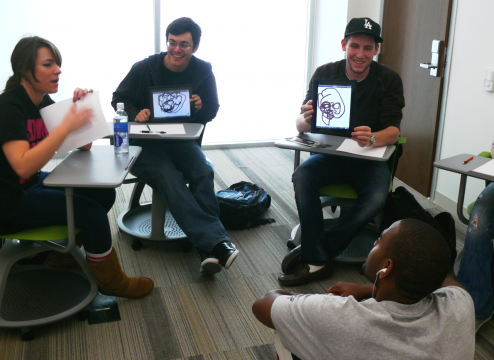
Animoto is an easy way to create pretty slick short films, combining video clips (under 10 seconds), with jpegs, and captions. This was my first try. I quickly recorded some clips of myself describing the methods of the class, added some images of student projects with text to label each image.
Animoto gives free accounts to educators. I plan to get my students to make some of these to document their projects next semester.
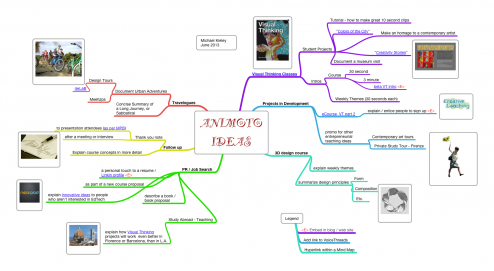
Just finished taking down the exhibit of 15 years of student work from Visual Thinking. The design and installation was a ton of work, but rewarding due to the positive feedback I received. Looking at the projects made by more than 900 students gave me an overview of where we’d been, which gave me ideas for where to head next. The gallery at Loyola is a gigantic, in some ways difficult to conquer space, but when I saw how good things looked upon completion, I realized that we are lucky to have such a large space in the LMU art department.
(Many of the installation photos are by Nicole Murph, who does so much to keep the art department running in an efficient manner.)
I have been reading a number of articles about MOOC’s, and looking at Coursera, and some of the other sites offering classes. While many of the courses, aren’t things I feel I need to study, I was intrigued at this Coursera offering on the subject of Creativity and Innovation, since it seems to parallel so many of the ideas I have been using in my Visual Thinking classes. It is an interesting contrast, since I developed my ideas based on experiences in contemporary art and psychology, and this course is taught by three professors of (Environmental, Chemical, and Mechanical) Engineering.
Creativity, Innovation & Change – Penn State University, Jack V. Matson, Darrell Velegol and Kathryn W. Jablokow
Optional Portals:
This is the second semester that the students of Visual Thinking have gone out to do field studies in some of the most color-filled neighborhoods of Los Angeles. One goal of this project is to learn more about how much color palettes, signs, symbols, and the foods of the neighborhood establish a very specific and unique sense of place.
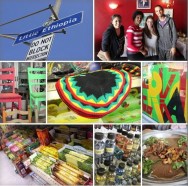
This is the second semester that students are conducting interviews of artists, inventors, and creative entrepreneurs, in order to learn directly about how individuals nurture their own creativity, and overcome obstacles.
We are gathering the responses in a VoiceThread. Here is the link: https://voicethread.com/share/4277698/
Feel free to add your own response, or comment on a story about someone else’s creative experiences.
The course focuses on the primacy of the visual experience, so rather than look at slides of art, we try to see as much work as possible ‘in the flesh.’ We study the work of Light + Space artists, such as Douglas Wheeler, Robert Irwin, and Larry Bell, because their work is rooted in direct experiences of art. 
We had our last meeting on Friday. We looked at the Rose Parade Projects, and spent most of the time working on the “Doorway to the Sanctuary” project.
Please try to finish the very last assignment by Friday, December 17th, in which you create your own VoiceThread in which you reflect on your experiences in the class. Those I’ve looked at so far have been very interesting, and helpful in planning future courses.
Thanks for participating in Visual Thinking.
Happy Holidays!
Update: A new VoiceThread was posted on November 29th. Please respond by midnight, on December 2nd.
SKETCHBOOKS ARE DUE ON DECEMBER 3rd. It is crucial that these be turned in on time.
We viewed, and voted on the 2nd round of the chair project. Evaluation was based on the second chair be transformed in such a way that is was the complete opposite of the aesthetic, and concept of the first chair.
We listened to an audio visualization exercise, by Shakti Gawain, titled, “Inner Sanctuary.” For the 3rd round of the chair project, the assignment is to transform it in a way that makes it perfectly suitable for you personal creative sanctuary.
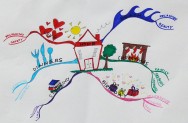 Mindmapping: an introduction. In class we made individual maps about “Happiness.” We then collaborated in pairs on a second mind map.
Mindmapping: an introduction. In class we made individual maps about “Happiness.” We then collaborated in pairs on a second mind map.
For next week, create two Mindmaps. These can be notes on a book or lecture, planning for a vacation, mapping out a creative project, or anything else you can think of in which the process might lead to new insights.
UPDATE: No VoiceThread for this week. I’ll add a couple questions to next week’s Vthread.
UPDATE #2: Here are the photos of the first round of the chair project. I will give you a print of your chair tomorrow.
1) We viewed the chair transformation project. Each student was asked to talk about their chair’s “Amazingness.” For next week, the chair is to be completely reconfigured as an opposite in every way of the first chair. One suggestion for this was to think of an “Evil Twin” taking over, and remaking the chair.
2) We watched a short clip on creativity training in dolphins, and then a bio on Jim Denevan, a highly created individual involved in making giant scale, ephemeral drawings, and collaborative food projects.
3) We listened to an excerpt from Shakti Gawain’s book on creativity. There was a list of questions about personal creativity, and if any negative self-talk occurs during this week’s project, try her technique for dealing with “The Inner Critic.”
4) We used the “Visit Ancient Egypt” exercise, in order to solve, or make progress on an immediate and pressing problem.
5) First individually, and then in pairs, we did a classic brainstorming exercise called, “Crossing a Chasm.” The goal of brainstorming is to get into a flow state, in which you develop a vast number of alternative solutions to a problem. This necessitates a temporary switching off of the analytical / logical part of the brain.
6) And we watched Ken Robinson’s lecture, “Do School’s Kill Creativity,” which summarizes part of his book, “The Element: How Finding Your Passion Changes Everything.”
We began by talking about the effects of early educational experiences on our current creative identity. We watched a clip from Truffaut’s film “The 400 Blows,” and an excerpt from Michael Apted’s documentary “7-Up” in which seven year olds describe how they imagine their futures. I read a description of the creative Italian school called Reggio Emilia, which has a motto, “Nothing Without Joy,” and then we talked about how this school compared with our own early schooling.
We recorded the “24 Objects” podcasts. I am in the process of editing these, and will send a link, once they are uploaded. Podcasts are available at the VT Podcasts page. Click on ‘subscribe’ to open in iTunes, and download into an iDevice, if you wish.
While one group recorded the podcasts, the other three teams discussed eleven creative questions.
A slideshow of “12 Creation Myths.”
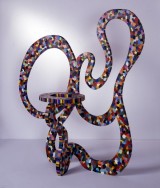 Finally, we made two clay chairs, and did a fill in the blank, called “Letting Go Exercise.”
Finally, we made two clay chairs, and did a fill in the blank, called “Letting Go Exercise.”
8″ tall black foam core chairs were given out. The assignment due at next week’s meeting is to transform these in a way that is AMAZING!
This weeks VoiceThread has just been posted.